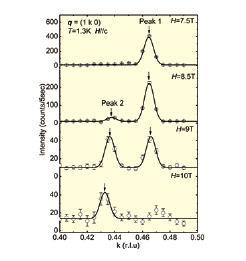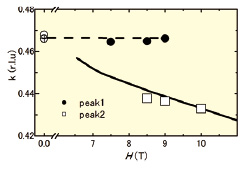Novel Magnetic State in Ferromagnetic Frustrated Chain LiCuVO4
Masuda Group
One of the recent interests in condensed matter science is to search for a spin liquid that exhibits order not in a conventional two-spin correlation but in other correlations such as magnetic multipole or spin chirality. A 1D frustrated spin chain with a ferromagnetic nearest-neighbor interaction (J1) and an antiferromagnetic next-nearest-neighbor interaction (J2) is diversity of such novel states. In zero field vector spin chirality does order with a broken Z2 symmetry [1]. At a field close to the ferromagnetic polarized phase, a pair of magnons form a bound state [2], and its Bose condensation at approximately q = π induces the quasi-long-range order of transverse spin nematic correlation ⟨S0+ S1+ Sl– Sl+1– ⟩ [3]. At the same time longitudinal two spin correlation exhibits spin density wave like sinusoidal behavior; ⟨S0z Slz⟩~Azcos(2kfl)/|l|η [4]. Here 2kf is the density of two-magnons. In real magnet, weak interchain interaction induces magnetic long-range order (LRO) at low temperatures but the LRO would inherit quantum nature. In the case of the vector chiral (VC) phase, a spiral order in which the magnitude of the magnetic moment is strongly suppressed owing to quantum fluctuation would be induced. In the case of nematic state, the LRO of the longitudinal spin correlation would appear with the propagating wave vector 2kF in reasonably high field region.

Fig. 1. Neutron diffraction profile at q = (1 k 0) in H k c at T = 1.3 K. Peak 1 is from the ab-plane spiral structure and peak 2 is from the spin density wave structure.

Fig. 2. Magnetic field dependence of Bragg peak positio.
LiCuVO4 is a candidate compound for 1D ferromagnetic frustrated system. At low temperature interchain interaction induces a spiral magnetic LRO in the ab-plane with a propagation vector ksp = (0 0.532 0) at zero and low magnetic field [5]. Magnetic excitation measured by inelastic neutron scattering experiment was explained by spin wave calculation based on ferromagnetic frustrated chain with J1 = -1.6 meV, J2 = 3.56 meV, and Jinter = -0.4meV [6]. The realized spin model is a weakly coupled ferromagnetic frustrated chain with a NNN AF interaction. Hence the observed spiral order in zero and low field is ascribed to the development of two spin correlation in the theoretically predicted VC order in the isolated chain. Applying high field would induce nematic-like state that is characterized by the longitudinal SDW with field dependent propagation vector. Indeed unknown high field phase was reported at H > 8 T. Here we report neutron diffraction study to reveal the nature of the new high field phase in LiCuVO4 [7].
Magnetic field dependence of neutron diffraction profiles at q = (1 k 0) (0 ≤ k ≤ 1) are collected at T = 1.3 K as shown in Fig. 1. At H = 7.5 T, a peak (peak 1) is observed at k ~ 0.465, which coincides with zero field data. With increasing field, peak 1 is suppressed and a new peak (peak 2) appears at k ~ 0.438 at 8.5 T. In addition, the intensity of peak 2 increases and its position changes. The field dependence of the peak positions are summarized in Fig. 2. The wave vector of peak 1 is constant and the ab spiral magnetic structure persists up to H ~ 9 T. The wave vector of peak 2 monotonically decreases with H. Solid curve is the field dependence of the characteristic vector 2kF of the nematic state that is theoretically calculated and the data is reasonably reproduced by the theory. Thus the high field phase in LiCuVO4 is identified as the long-range order of the longitudinal sinusoidal spin correlation originally predicted in an isolated ferromagnetic frustrated chain.
References
- [1] A. Kolezhuk and T. Vekua, Phys. Rev. B 72, 094424 (2005).
- [2] A.V. Chubkov, Phys. Rev. B 44, 4693 (1991).
- [3] L. Kecke, T. Momoi, and A. Furusaki, Phys. Rev. B 76, 060407 (2007) .
- [4] T. Hikihara, L. Kecke, T. Momoi, and A. Furusaki, Phys. Rev. B 78, 144404 (2008).
- [5] B.J. Gibson et al., Physica B 350, e253 (2004).
- [6] M. Enderle et al., Europhys. Lett. 70, 237 (2005).
- [7] T. Masuda, M. Hagihala, Y. Kondoh, K. Kaneko, and N. Metoki, J. Phys. Soc. Jpn. 80, 113705 (2011).
